Subway tile has been a kitchen staple for years, but let’s be honest—it’s everywhere. Homeowners now want something fresh to show off their own style. Those familiar white rectangles? They’re not your only route to a beautiful, functional backsplash anymore.
Remember to repin your favorite images!
Ceramic tiles that break away from the subway look bring a wild mix of shapes, colors, and patterns. They’re affordable, practical, and can totally change the vibe of your kitchen.
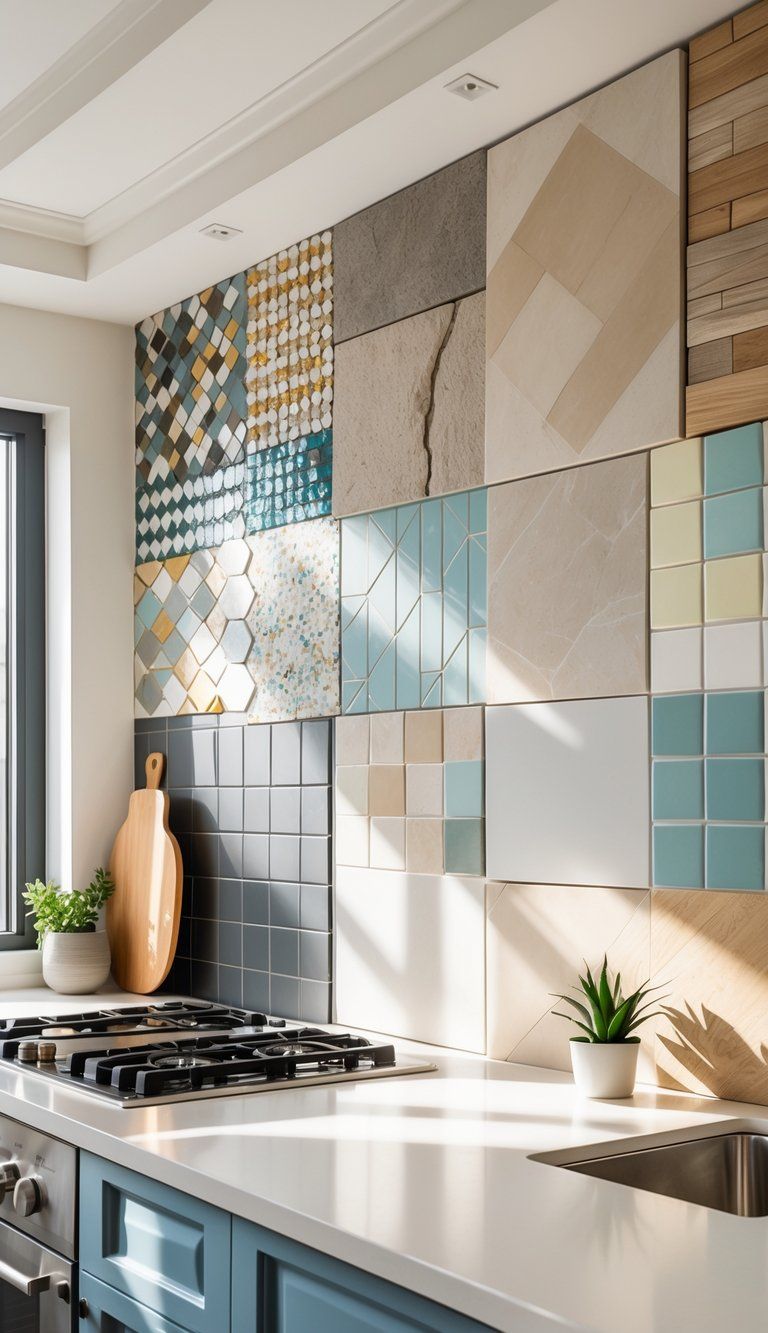
Your backsplash doesn’t even have to be tile. Chalkboard paint, wooden planks, or bold patterned surfaces can add visual punch and work with your cabinets instead of fading into the background. In Spanish-style kitchens, designers sometimes mix simple, budget-friendly tiles with borders of fancier pieces for a look that’s got personality.
Thinking about a kitchen update? Forget the white rectangles for a minute. Look for options that actually reflect your taste. Maybe blue patterned tiles will pop against your neutral cabinets, or you could mix different tile shapes for a custom design. The right backsplash should balance your need for something pretty with the practical job of protecting your walls from kitchen chaos.
Why Look Beyond Subway Tile for Kitchen Backsplashes
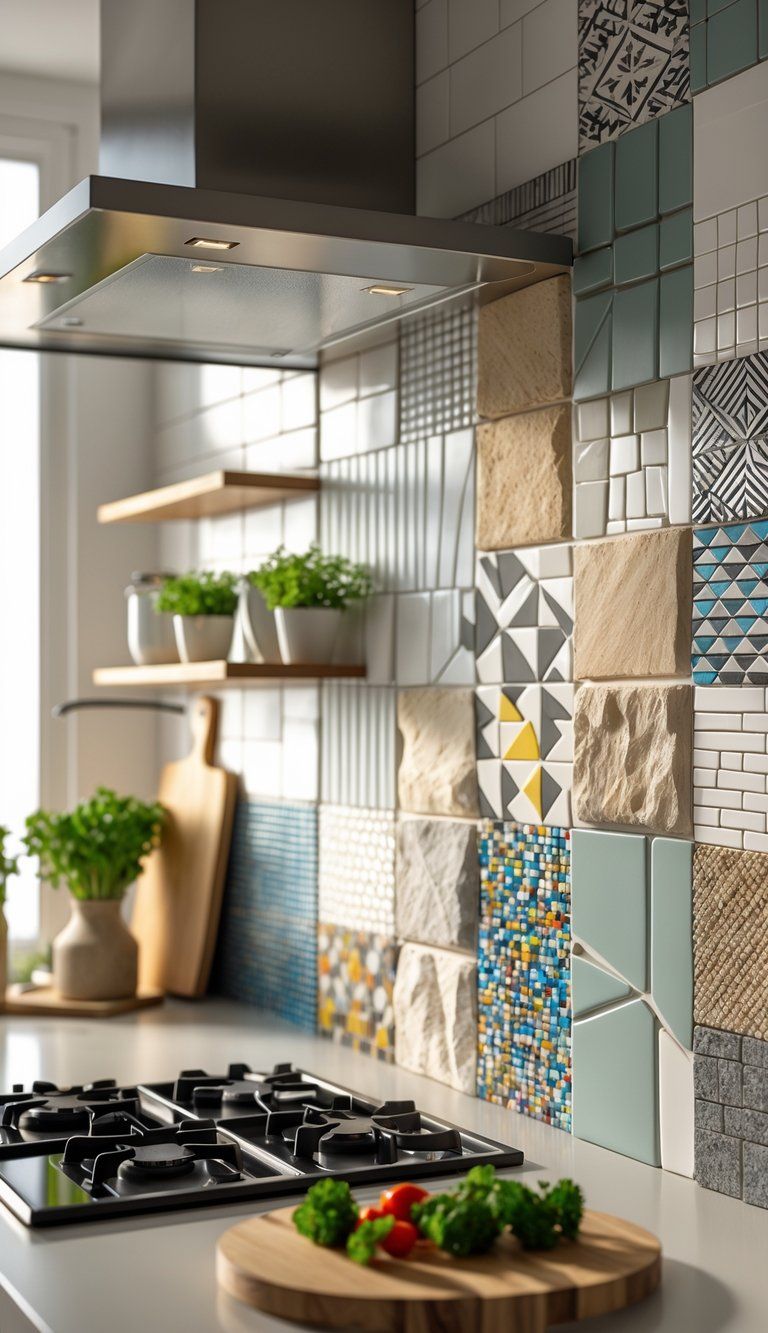
Subway tile still gets a lot of love, but trying out new backsplash options can give your kitchen more personality and maybe even fit your needs better.
Limitations of Subway Tile
Subway tile feels overdone in modern kitchens. After seeing it in so many homes and on every design show, people start wanting something different. That simple rectangle? It’s clean, sure, but it just doesn’t offer much visual excitement.
Grout lines in subway tile installations can turn into a cleaning headache. Dirt, grease, and food get stuck in there, and over time, grout lines discolor—especially behind the stove or sink.
Subway tile isn’t the most flexible design-wise, either. It doesn’t always fit with contemporary or eclectic kitchens that want a bit more drama.
Benefits of Exploring Alternative Materials
Trying something other than subway tile opens up a whole world of design. Colored glass tiles can reflect light and add depth that ceramics just can’t match. Marble tiles bring in natural elegance and veining for a one-of-a-kind look.
Alternative materials often work better with what you’ve already got. Patterned tiles can tie in with your floors or countertops, pulling the whole kitchen together.
Some choices are just more practical. Porcelain is more water-resistant than ceramic subway tile, so it’s great for splash zones.
A bold backsplash can become the star of your kitchen. Floor-to-ceiling patterns or a wild mix of tiles bring energy that plain subway tile can’t really deliver.
Popular Kitchen Backsplash Alternatives
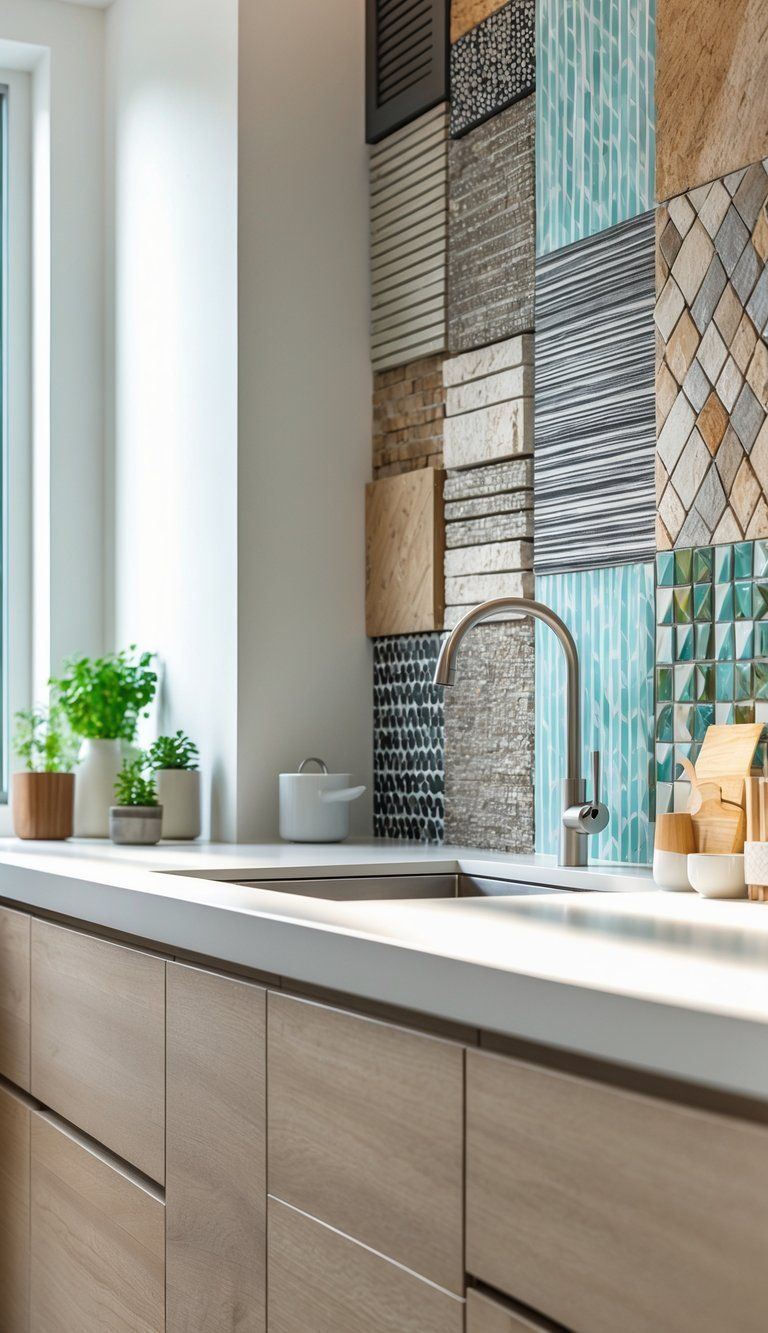
When you skip the usual subway tiles, your backsplash options get a lot more interesting. These alternatives can really transform your kitchen and still do the job of protecting your walls.
Marble Slab Backsplash
A marble slab backsplash gives your kitchen a seamless, luxe vibe. You won’t have to worry about grout lines, so cleaning gets way easier.
You can run your countertop material right up the wall for a dramatic, modern feel. Just order a bit of extra stone when you get your countertops.
Marble slabs come in all sorts of colors and veining. White with gray veins is a classic, but you could go for:
- Cream with gold veining
- Deep black with white streaks
- Green marble if you want something different
Marble costs more upfront, but it can bump up your home’s value and doesn’t need as much cleaning as tile with lots of grout.
Cement Tile Designs
Cement tiles bring bold patterns and color, making your kitchen stand out. Handcrafted cement tiles have warmth and personality that mass-produced tiles just don’t.
You often see Spanish or Moroccan-inspired designs. Try installing them behind the stove for a focal point and use simpler tiles elsewhere to save some cash.
Cement tiles fit into all sorts of kitchen styles:
- Traditional: Classic geometry
- Bohemian: Colorful, eclectic patterns
- Modern: Simple, clean lines
Seal cement tiles to keep stains away, and expect them to develop a patina as they age. A little wear just adds charm.
Glass Tile Trends
Glass tiles bounce light around and make small kitchens feel bigger. Their shine can open up the whole space.
You can find glass tiles in every color, from soft neutrals to bright jewel tones. Some ways to use them:
- Mosaics: Mix different shades for depth
- Large glass panels: For a sleek, modern look
- Recycled glass: Eco-friendly and full of character
Glass tiles don’t stain and don’t need sealing. They’re non-porous, so bacteria won’t stand a chance—perfect if you cook a lot.
Hexagon Tile Patterns
Hexagon tiles, or “hex tiles,” are a cool geometric twist on rectangles. Their six sides make for a modern, interesting look.
Try them in different ways:
- One color for subtle texture
- Contrasting colors for patterns
- Ombre fades from dark to light
You can go big or small with hex tiles. Larger ones make a statement, while tiny honeycomb patterns add a delicate touch.
People often pick white or neutral hex tiles, but why not go bold? Navy, green, or black hexes can make your backsplash look super sophisticated.
Hexagons work with both modern and classic cabinets, so they’re a safe bet if you want something different but not too wild.
Unique Shapes and Patterns in Backsplash Design
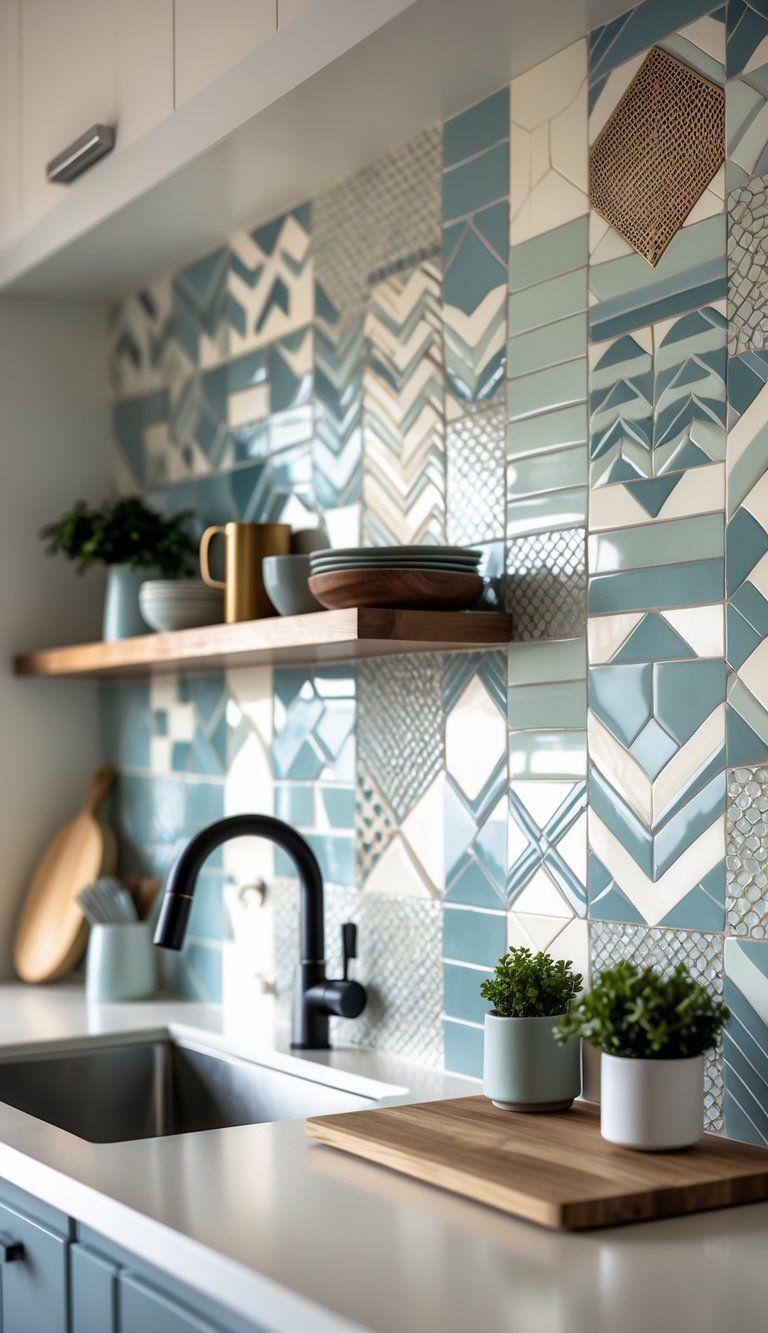
Backsplash design has come a long way from basic subway tile. Kitchens now show off all sorts of shapes and patterns that turn the wall into a real focal point.
Arabesque Tiles
Arabesque tiles add instant elegance with their curved, almost romantic shapes. The design draws from Moorish architecture, giving your kitchen a little old-world flair.
These tiles create soft lines and a cozy vibe, especially in traditional or transitional kitchens. You can get them in ceramic, porcelain, or even stone.
Go for white or cream if you want something subtle. If you’re feeling brave, try navy or emerald green for drama.
Pair arabesque tiles with simple cabinets to let the shape stand out. They look especially good behind the stove or sink as a statement.
Geometric Shapes
Geometric tiles open up endless possibilities. Hexagons, diamonds, triangles, and pentagons can form patterns that are either low-key or totally bold.
Hex tiles are everywhere lately and give a modern honeycomb look. You can stick to one color or mix it up for extra depth.
Triangle tiles let you play with color and create cool effects, like 3D cubes or random, artsy arrangements.
Mixing geometric shapes can make your backsplash look like a piece of art. Hexagons and triangles together? Why not!
These shapes work best in modern kitchens but can surprise you in more classic spaces too.
Square Tile Layouts
Square tiles might seem basic, but how you lay them changes everything.
Try different layouts:
- Straight set: Classic grid
- Diagonal: Turned 45 degrees for diamonds
- Basketweave: Mix up the direction for texture
- Herringbone: Zigzags for movement
Mixing sizes can give you a mosaic effect. Use tiny squares with bigger ones for texture.
Change up the colors for an ombré look that fades from light to dark.
Big, square tiles with minimal grout lines look super modern and sleek.
Natural Materials for Kitchen Backsplashes
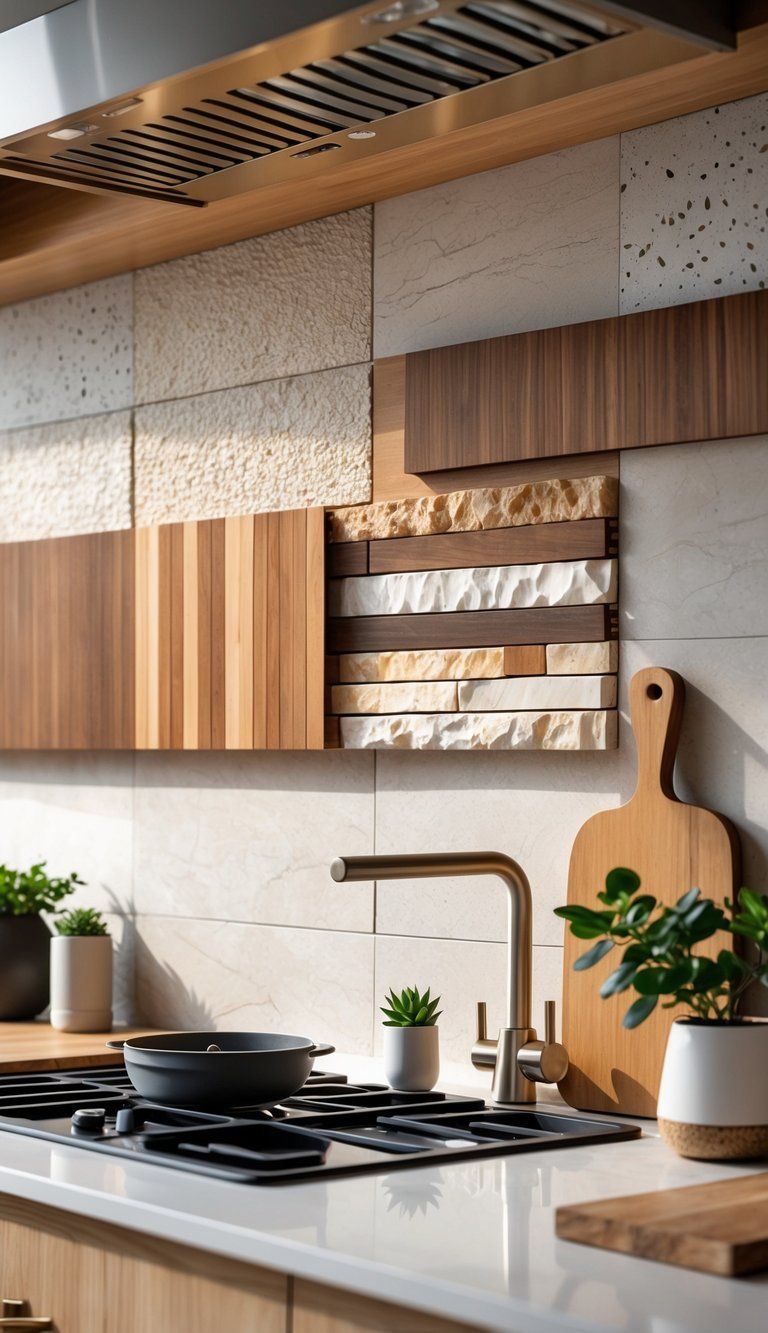
Natural materials bring warmth, texture, and a unique feel to your kitchen backsplash. They give your space a personality that manufactured tiles often miss.
Travertine
Travertine, a natural stone, gives your kitchen an earthy, sophisticated look. It comes in warm, neutral colors like ivory, beige, and rustic browns.
Unlike ceramic, travertine has natural pits and texture for extra depth. Pick polished travertine for sleekness or tumbled for a rustic vibe.
Travertine is tough, but you’ll need to seal it since it’s porous. That step is important to keep stains away, especially in splash-prone areas.
Installation costs more than regular tile, but the timeless look often boosts your home’s value. Pair it with wood cabinets for warmth or with modern white cabinets for contrast.
Wood Paneling Options
Wood backsplashes make kitchens feel cozy and inviting. Some popular choices:
- Shiplap: Horizontal planks for a farmhouse or beachy vibe
- Beadboard: Classic cottage style
- Reclaimed wood: Adds character and is eco-friendly
Protect wood with several coats of polyurethane or marine varnish. This keeps moisture out, which is crucial near sinks.
If you’re worried about splashes, try wood panels above the stove instead of behind the sink. Or use wood-look porcelain tiles for easier upkeep.
Wood backsplashes look great with both painted and natural cabinets. The grain adds interest without taking over the whole design.
Brick Backsplash
A brick backsplash gives your kitchen instant character and a timeless feel. You can pick real brick veneer or brick-look porcelain for easier installation.
Exposed brick feels warm and rustic, or even industrial if you go that way. Paint the brick white or another color for a more modern twist.
Seal brick to prevent moisture problems and make cleaning easier. Refresh the sealer every year or two.
Brick’s texture catches light differently throughout the day, so your kitchen never looks exactly the same. That natural variation gives the space depth you just don’t get with flat tile.
Brick works well with wood counters, stainless appliances, and both light or dark cabinets. It’s a flexible, natural choice that suits a lot of styles.
Specialty Tile Options
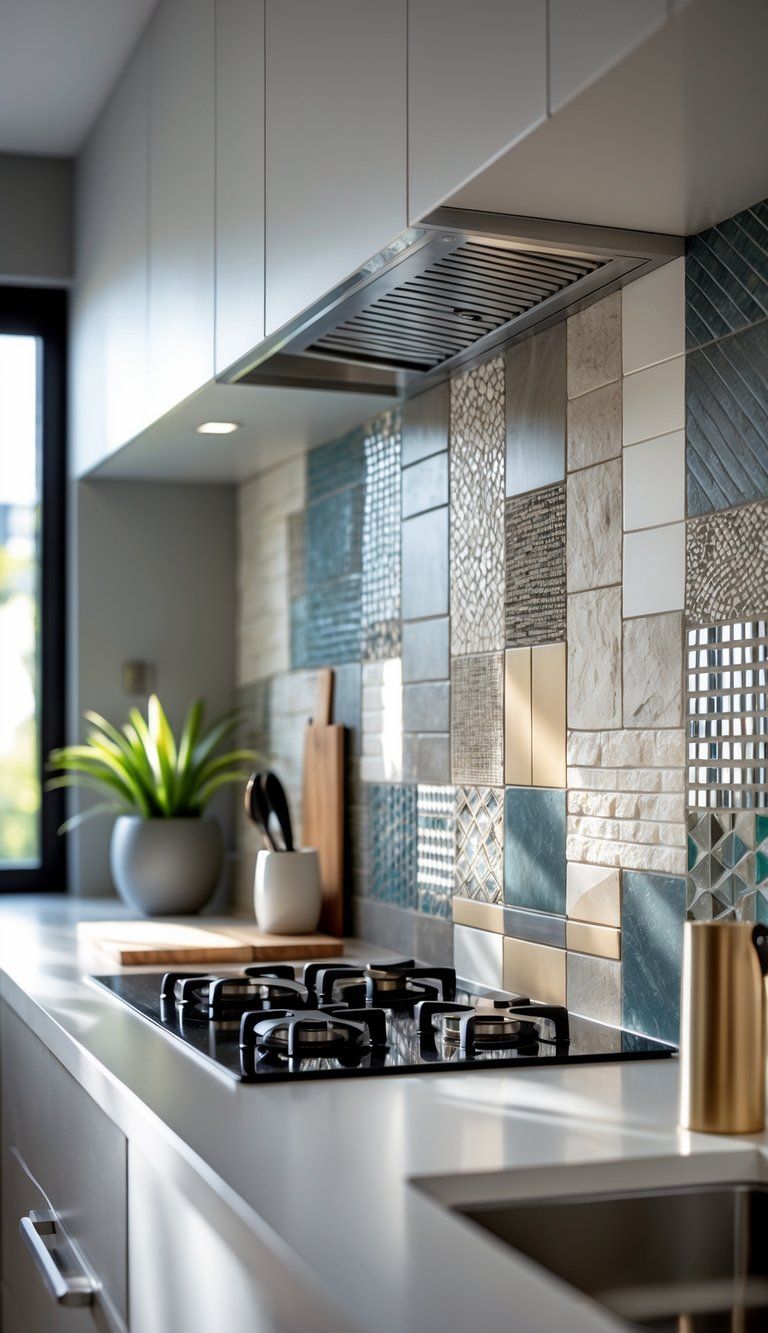
If you’re ready to ditch the subway tile, specialty tiles can bring unique textures and eye-catching detail. These unusual options can turn your kitchen into something truly memorable.
Zellige Tile Charm
Zellige tiles instantly bring Moroccan craftsmanship to your kitchen. Each one shows off slight variations in color, thickness, and sheen, so the surface always feels lively and catches the light from different angles.
The imperfect edges and unique glaze give zellige tiles a warm, artisanal vibe. Most come as 4×4-inch squares, but you’ll find other sizes and shapes if you look around.
These tiles work in both traditional and modern kitchens. Their glossy finish bounces light around, which helps smaller kitchens look a bit bigger.
Earthy neutrals, soft blues, and greens are popular picks—they add color but don’t shout for attention.
Installing zellige tiles takes skill because of their handmade, uneven edges. Expect to budget about $20-40 per square foot if you want quality options.
Porcelain Tiles
Porcelain tiles give you tons of versatility and serious durability for kitchen backsplashes. Manufacturers make them from fine clay and fire them at high temperatures, so you get a dense, water-resistant tile that stands up to splashes.
Modern techniques let porcelain mimic almost any material—marble, wood, concrete—without all the upkeep headaches. Large-format porcelain tiles cut down on grout lines, which makes the look feel seamless and sleek.
There are so many colors, patterns, and finishes out there. Matte options keep glare down, while glossy ones brighten things up. Digital printing brings in detailed designs, from bold geometric patterns to nature-inspired looks.
Porcelain usually costs less than most natural materials—think $3-30 per square foot, depending on what you choose. You can clean them easily with just mild soap and water.
Innovative Backsplash Ideas
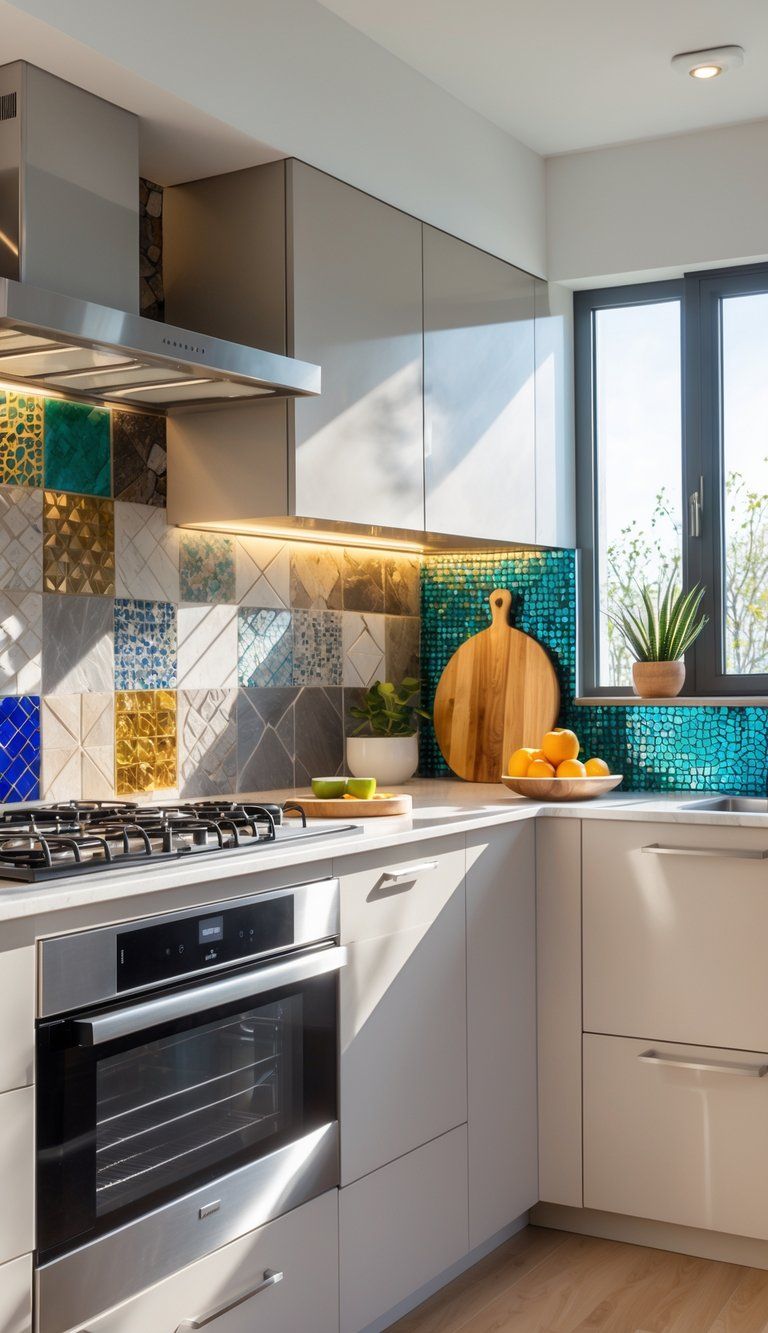
If you look past the usual tile options, you can really transform your kitchen with unique textures and visual interest. Creative materials help your kitchen stand out but still protect your walls like a good backsplash should.
Shiplap Accents
Shiplap brings a bit of farmhouse charm and texture to your kitchen, and you don’t have to deal with grout lines like you do with tile. This horizontal wooden paneling creates a cozy, welcoming atmosphere and fits all sorts of kitchen styles.
Paint shiplap white for a crisp, bright look, or go for a bold color if you want something that pops. To handle kitchen messes, seal your shiplap with a waterproof finish.
It’s usually easier to install than tile. The horizontal lines can make your kitchen look wider, which is handy if you’re working with a smaller space.
You can use shiplap for the whole backsplash or just as an accent behind the stove or sink.
For a modern twist, try narrow boards or paint them in a fresh color like navy blue or sage green. It’s a fun way to get that shiplap texture with a more updated vibe.
Incorporating Alternative Backsplashes Into Kitchen Design
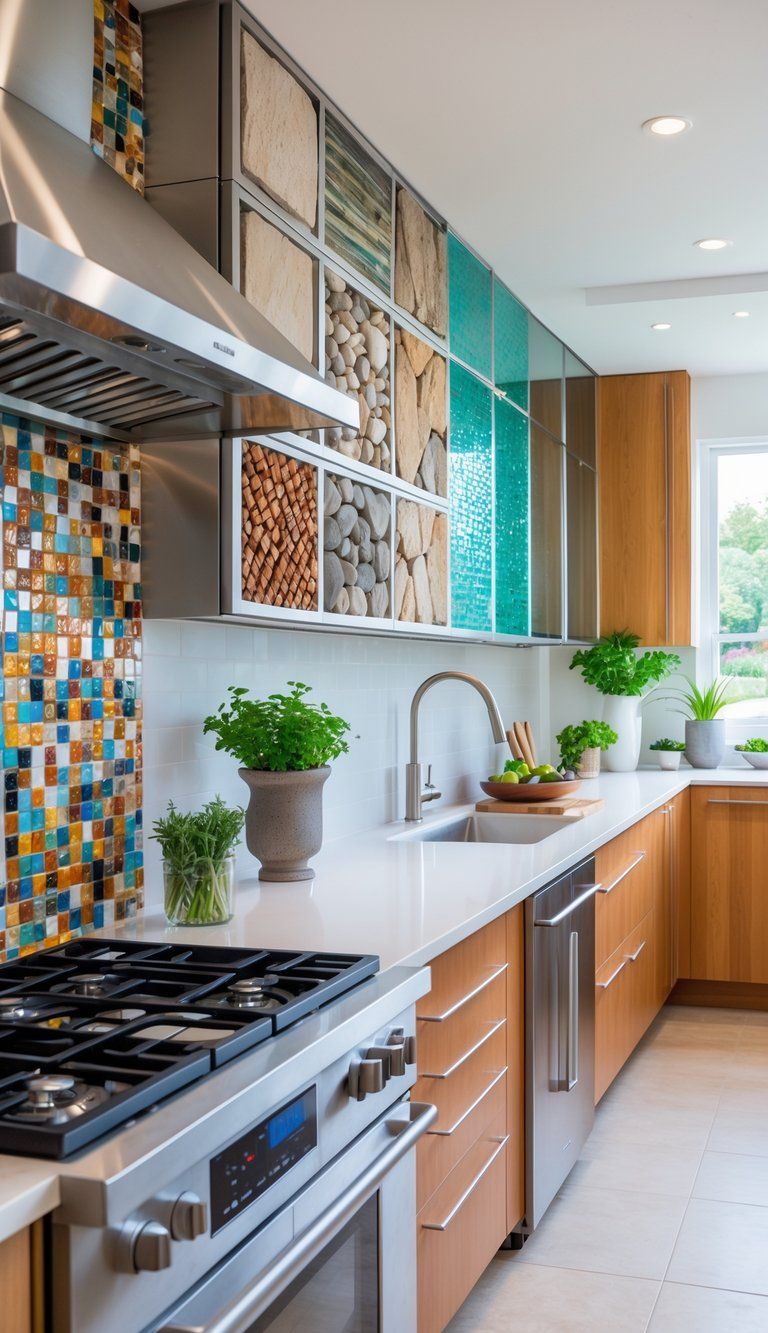
The right backsplash material can really change your kitchen’s look and keep your walls safe. Alternative backsplash options let you show off your style, especially if you’re tired of subway tiles.
Blending Styles for Home Design
When you add unique backsplash materials, think about how they’ll play with the rest of your kitchen. Wood backsplashes bring warmth and texture to modern kitchens with sleek cabinets.
A reclaimed wood backsplash looks great with industrial fixtures or a farmhouse sink.
Metal sheets add durability and a modern touch. Copper or stainless steel backsplashes bounce light around and make small kitchens feel a bit bigger. They pair nicely with both light and dark cabinets.
Natural stone gives you a timeless look that bridges traditional and modern styles. Think about how your backsplash works with your countertops and floors. The idea is to create a sense of harmony, not a competition between surfaces.
Tips for Kitchen Renovation
Grab a few material samples for your backsplash and actually test them out in your kitchen. Trust me, the lighting changes everything—check them at different times of day and see what feels right.
Budget considerations:
- You can save some cash with alternatives like wood panels or metal sheets instead of splurging on fancy tiles.
- Remember to add installation costs, since those can shift a lot depending on how tricky your material is.
- Set aside a 10-15% buffer, just in case something unexpected pops up (and it usually does).
Maintenance matters more than you might think. Glass backsplashes look amazing, but wow, they pick up fingerprints fast. Natural stone, on the other hand, needs sealing every so often. Try to pick something that matches how much cleaning you’re willing to do.
If you’re going the DIY route, stick with simpler stuff—peel-and-stick tiles or big panels are way more forgiving. For complicated patterns or materials that need special tools, it’s probably best to call in a pro.

